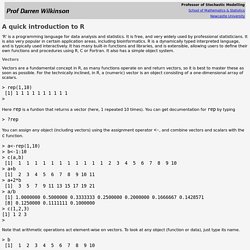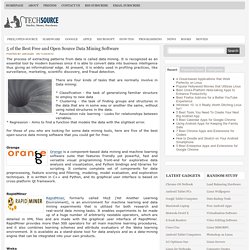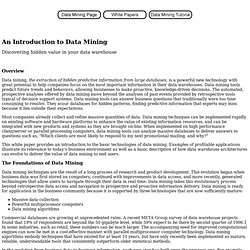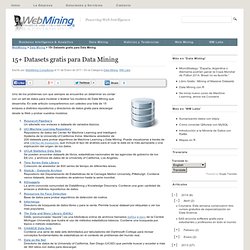

Nearest Neighbour Algorithm - Data Mining. A quick introduction to R. 'R' is a programming language for data analysis and statistics.

It is free, and very widely used by professional statisticians. It is also very popular in certain application areas, including bioinformatics. R is a dynamically typed interpreted language, and is typically used interactively. It has many built-in functions and libraries, and is extensible, allowing users to define their own functions and procedures using R, C or Fortran. It also has a simple object system. Vectors Vectors are a fundamental concept in R, as many functions operate on and return vectors, so it is best to master these as soon as possible. > rep(1,10) [1] 1 1 1 1 1 1 1 1 1 1 > Here rep is a funtion that returns a vector (here, 1 repeated 10 times). > ? You can assign any object (including vectors) using the assignment operator <-, and combine vectors and scalars with the c function.
Note that arithmetic operations act element-wise on vectors. > b [1] 1 2 3 4 5 6 7 8 9 10 To list all of your objects, use ls(). Top 10 Programming Languages to Keep You Employed - Application Development. By Darryl K.

Taft | Posted 2010-06-21 Email Print If you want to make money in programming what are the best languages to learn? Well, eWEEK put this question to a host of developers, recruiters, born-on-the-Web startups and the creators of some of the most widely used programming languages out there. Top 10 Programming Languages to Keep You Employed by Darryl K. Darryl K. 5 of the Best Free and Open Source Data Mining Software. The process of extracting patterns from data is called data mining.

It is recognized as an essential tool by modern business since it is able to convert data into business intelligence thus giving an informational edge. At present, it is widely used in profiling practices, like surveillance, marketing, scientific discovery, and fraud detection. There are four kinds of tasks that are normally involve in Data mining: * Classification - the task of generalizing familiar structure to employ to new data* Clustering - the task of finding groups and structures in the data that are in some way or another the same, without using noted structures in the data.* Association rule learning - Looks for relationships between variables.* Regression - Aims to find a function that models the data with the slightest error. Data Mining and Statistical Modeling. A recurring question and point of debate in the realm of analytics is whether there exists any meaningful difference between data mining and statistics.

(Text mining or text analytics is not addressed here, although this area of unstructured or semi-structured data analysis has certain similarities as well as points of integration with data mining, the latter dealing with structured data.) Some regard statistics as referring to hypothesis-driven analysis of smaller data sets, while data mining refers to discovery-driven analysis of large databases. Others view the two terms as simply different names for extracting useful information and deriving conclusions from data. Statistical Data Mining. An Introduction to Data Mining. An Introduction to Data Mining Discovering hidden value in your data warehouse Overview Data mining, the extraction of hidden predictive information from large databases, is a powerful new technology with great potential to help companies focus on the most important information in their data warehouses.

Data mining tools predict future trends and behaviors, allowing businesses to make proactive, knowledge-driven decisions. The automated, prospective analyses offered by data mining move beyond the analyses of past events provided by retrospective tools typical of decision support systems. Most companies already collect and refine massive quantities of data. Data Mining: What is Data Mining? Overview Generally, data mining (sometimes called data or knowledge discovery) is the process of analyzing data from different perspectives and summarizing it into useful information - information that can be used to increase revenue, cuts costs, or both.

Data mining software is one of a number of analytical tools for analyzing data. It allows users to analyze data from many different dimensions or angles, categorize it, and summarize the relationships identified. Technically, data mining is the process of finding correlations or patterns among dozens of fields in large relational databases. Continuous Innovation Although data mining is a relatively new term, the technology is not. Example For example, one Midwest grocery chain used the data mining capacity of Oracle software to analyze local buying patterns. Data Mining. 15+ Datasets gratis para Data Mining.
Uno de los problemas con que siempre se encuentra un dataminer es contar con un set de datos para modelar o testear los modelos de Data Mining que desarrolla.

En este artículo compartiremos con ustedes una lista de 15 enlaces a distintos repositorios y directorios de datos gratis para descargar desde la Web y probar vuestros modelos: Research Pipeline’s Un sitio/wiki con enlaces a datasets de variados tópicos.UCI Machine Learning Repository Repositorio de datos del Center for Machine Learning and Intelligent Systems de la University of California Irvine. The R Project. Data Mining.